| Web
and Book design,
Copyright, Kellscraft Studio 1999-2010 (Return to Web Text-ures) |
 (HOME)
|
| CHAPTER XIV
SOME INDIAN STITCHES THERE is a charm in the names of such Indian materials as spruce-root, cedar-bark, yucca and Indian hemp, but even if they were obtainable, they would be useless to us without the Indian touch; so we will substitute more available materials, those we have become familiar with in the preceding chapters. Rattan, both round and flat, in different sizes, may be used where a stiff, heavy material is needed, and raffia, rush, or split cane, where a more pliable one is required. Sweet-grass and the splints on which it is woven by the Eastern Indians and half-breeds may be bought, usually where the baskets are sold. In a previous chapter there is a description of the Indian arrangement of spokes. Where more than four spokes are to be used they are arranged according to the following diagram (Fig. 35).
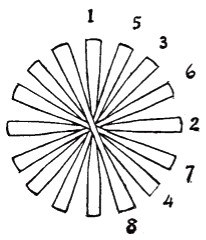  FIG. 35 FIG. 36 Sometimes the weaver is of the plain sweet-grass, sometimes it is braided, and it is either woven in under-and-over weaving or pairing. If in under-and-over weaving, as there is an even number of spokes, the weaver at the beginning of the second row must pass under two spokes in order to have the work come out right. This must be done at the beginning of every new row. Pairing is not as often used by the Indians as the Indian pairing or twining. In twining the Indian twists her two weavers in the opposite way from ours (see Fig. 36), making a stitch which runs diagonally down from left to right. A half turn is given as in our method, but whereas in pairing the half turn is made as if one were turning a screw to fasten it, the motion in twining is that made when unscrewing. Usually but one spoke is inclosed by two of these twists, but sometimes, as in Fig. 37, the skip stitch, which incloses two spokes, is introduced to form a pattern; and occasionally it is used for the body of the weaving (see Fig. 38).
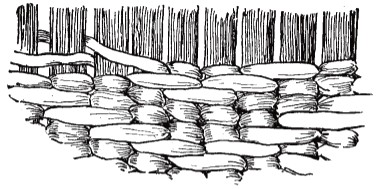 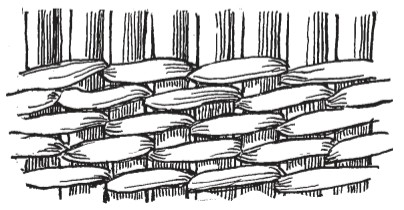 FIG. 37 FIG. 38
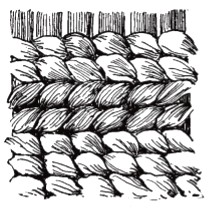 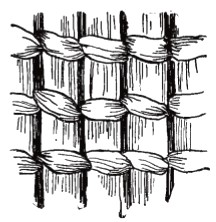 FIG. 39 FIG. 40 Ornamental bands or patterns are often worked in stitches which pass between the two weavers, as in aresene embroidery, showing only on the outside. These stitches give the effect of bands of pairing (see Fig. 39). Rows of twining are sometimes set far enough apart to produce an open work effect (see Fig. 40). Again they form part of a diamond pattern like that shown in Fig. 41, which was copied from an Aleutian wallet of sea-grass. The spokes in the original are of coarse straw, but in working out the pattern raffia or rush may be used as spokes, and raffia for the weaver. The lower part of the pattern is in open work twining; the upper is made by splitting each spoke and joining the right half of each one with the left half of the spoke at the right of it, with twining. The succeeding rows are woven in the same way. Rows of twining are also used in a hexagonal pattern made by the Makah Indians (see Fig. 42). Bottles are often covered with this weave. The bottom is started with spokes radiating from the centre. Those in the original were of bast, but rush or raffia may be used. Every other spoke is brought diagonally to the right, crossing over the next one which is brought to the left. After crossing, the spokes are held in place by a row of twining. A charming wallet made by the Nez Percé Indians, from the bast of hemp, suggests a simple and attractive way of making a flat envelope shaped basket for photographs or postal cards. It may be woven on splints with sweet-grass, or even on flat rush with colored raffia. There should be as many spokes as, when laid side by side close together, will make the width desired. They should be cut twice and a half as long as the finished basket is to be. After wetting the spokes until they are quite pliable, a row of pairing is woven joining them together in the middle. The ends of the spokes are then brought up together, and by continuing the pairing around and around the basket is built up. The edge is finished as some of the sweet-grass baskets are. Every other spoke is cut short, while the alternate ones are left about three-quarters of an inch above the weaving. These are then thoroughly wet, and bent sharply down inside the basket over a piece of splint which is fitted around inside the rim of the basket with its ends overlapping. A second piece of splint covers the spokes on the inside and on the outside a rope of sweet-grass, or whatever the weaver may be, is laid around in the same way. A weaver is then started on the inside of the basket close to the edge and sewed over and over, passing between two spokes each time, and binding the splint on the inside and the rope on the outside close together, as it goes under and over them. A cover may be made just large enough to fit over the basket and finished in the same way. On such a basket, woven of pale green raffia, bands of raffia in the natural color are effective, or designs may be embroidered on it externally as already described.
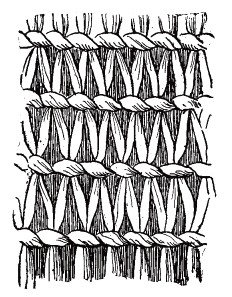 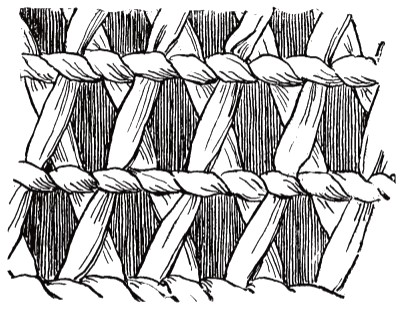 FIG. 41 FIG. 42
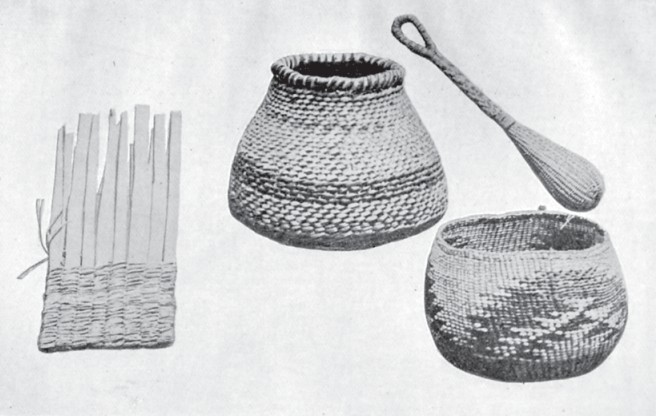
TWINED BASKETS The basket in the centre is made with the twining which incloses two spokes in each stitch. The one at the right is of the simple twining. Above and on the right is a rattle made of raffia on rattan spokes. On tha left the unfinished basket is of colored raffia on rush spokes
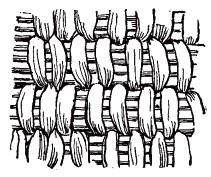 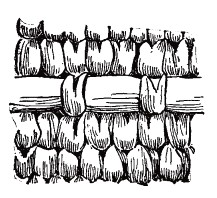 FIG. 43 FIG. 44 The coiled baskets of the Apaches, Paiutes, Navajo and Pimas are made of coiled osiers, or bundles of yucca whipped or wound with split osier or splints of pine. We can follow the stitch if not the rigidity and strength of these baskets by using single coils of No. 5 round rattan, or bundles made up of three or more strands of No. 2 rattan, coiled and wound with raffia. The rattan should be wet until pliable. It is then coiled into the smallest possible ring, and sewed over and over with a strand of raffia in a No. 19 tapestry needle. Beginning with the second coil, each time the raffia is wound around it is brought through the stitch just below it (see Fig. 43). Ornamental bands are sometimes added by laying a colored weaver along and catching it down with every third stitch (see Fig. 44). Another coiling stitch is made by bringing the weaver over the coil which has just been laid along and down under the coil below, locking into the stitch beneath that lower coil (see Fig. 45). A border which is often seen on coiled baskets, and which looks like braiding on a whip, is quite simple to make, much more so than one would think.

COILED BASKETS
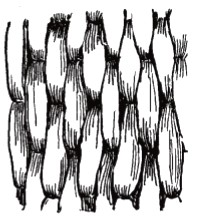 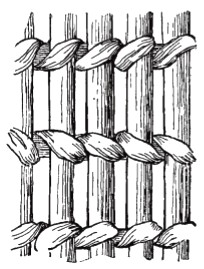 FIG. 45 FIG. 46 A single weaver, preferably of splint, is passed under the sewing of the last coil, then drawn over it and backward. It is next brought under again, upward and forward, just in front of the point where it started. In this way, by sewing first backward and then forward, as one would coil a kite string, the braided border is made with a single weaver. The bird-cage stitch of the Clallam and Makah Indians is sometimes woven with an open mesh, and sometimes close and fine. In copying the open-meshed weave shown in Fig. 46, No. 4 rattan may be used for the vertical spokes, No. 3 rattan for the horizontal coil and raffia for the weaver. The horizontal coil is laid back of the vertical spokes, and a single weaver of raffia binds the vertical spokes to the coil where they cross. The rows are about a quarter of an inch apart. In the close weave the spokes, horizontal coil and weaver are more uniform in size. No. 2 rattan may be used for the spokes and coil, and raffia for the weaver. The stitch is the same except that the rows are brought close together, and as the weaving progresses; the spokes, being quite pliable, bend forward in the direction the weaving takes; making an unusual and attractive surface (see Fig. 47).
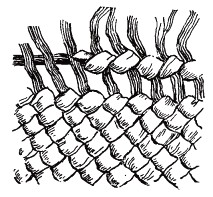 FIG. 47 |